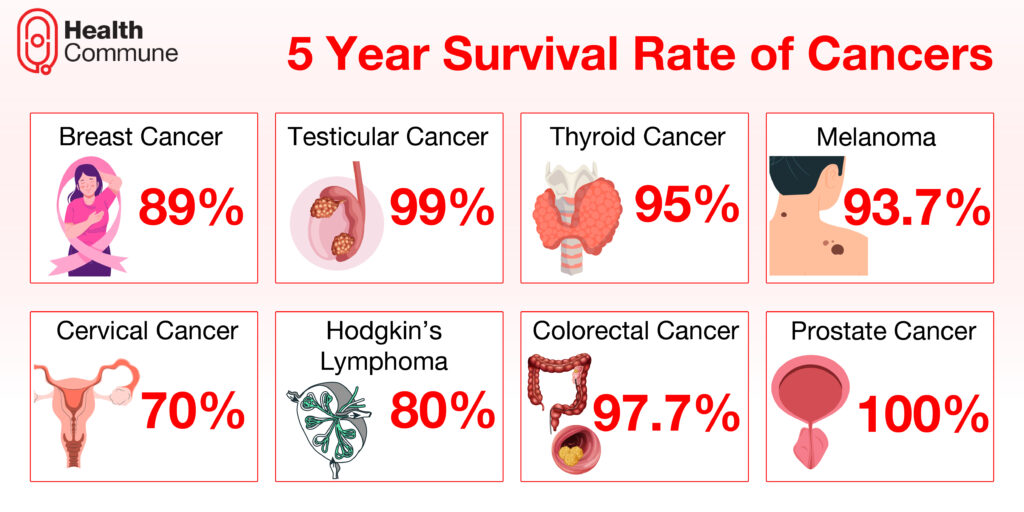Did you know that the cancer prognosis of cancer is largely determined by the stage at which it is diagnosed? Successful treatment is influenced by a variety of variables, and researchers frequently use the 5-year survival rate to evaluate the prognosis of various cancers. This represents the percentage of people who continue to live for five years after receiving a cancer diagnosis. Read on to know which cancers have the highest 5-year relative survival rates.
Breast cancer
- The overall 5-year survival rates for breast cancer are approximately 95% for stage I patients, 92% for stage II, 70% for stage III, and a mere 21% for stage IV patients
- Staging includes information about the tumour’s size and location
- In Stage 1, the tumour is confined mainly to the breast tissue, or in a few cases, the lymph nodes are present very close to the breast tissue
- Stage 2 breast cancer involves cancer of the breasts and the surrounding lymph nodes
Testicular cancer
- Testicular cancer has a 99% relative survival rate after five years for localised tumours that are present in the testicles
- Survival rates for regional tumours which have spread to tissues or lymph nodes close to the testicles are 95%
- Testicular cancer is usually treated by the removal of one or both testicles

Thyroid cancer
- At stages 1 and 2, the 5-year relative survival rate for thyroid cancer is 95%
- Most thyroid cancers develop slowly, providing more time for treatment
- The thyroid gland can be removed to effectively treat cancer, even when it has progressed to nearby throat tissues
Melanoma
- Around 93.7% of melanoma patients survive the disease five years after diagnosis at stage 1
- It has a high survival rate due its ease of detection in the body
- The likelihood of survival increases when melanoma is detected and treated early on in the disease’s course
- If not found in the early stages, melanoma can spread beneath the skin’s surface and become more difficult to remove
Cervical cancer
- All localised stages of cervical cancer have a 5-year relative survival rate of 70%
- The malignant cells in cervical cancer grow relatively slowly, even in the later stages. Therefore, treatment can still be successful
Hodgkin’s lymphoma
- The 5-year relative survival rate for Hodgkin’s lymphoma is 80% during stages 1 and 2
- Hodgkin’s lymphoma has a high relative survival rate because it responds effectively to radiation therapy
- This also indicates that for those with more severe types of this malignancy, the survival percentage is still very high
Colorectal cancer
- Colorectal cancer has a 65% five-year overall survival rate, but it has a 97.7% five-year survival rate when detected early
- Regular colorectal cancer screening from the age of 50 years is the best strategy to improve survival outcomes
Prostate cancer
- The 5-year relative survival rate for early stages of prostate cancer is nearly 100%
- Prostate cancers are relatively curable, as they grow very slowly or do not grow or spread at all
- Prostate cancers that are not growing are monitored over time to see if they grow in size or spread to surrounding areas





